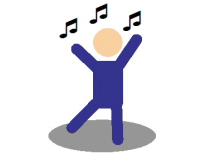
One of the things in teaching music that has baffled me for some time is why students seem to have as much trouble as they do reading music. Part of it, I’ve long thought, is due to trying to teach “sight” before “sound.” If nothing else, Gordon’s research taught us that children learn to read music like they learn to read language; first by hearing and learning patterns, using them aurally, and then connecting them to written symbols. Even so, it has seemed to me that children struggle to read music more than this theory suggests they ought. The first clue is found in that Gordon separated rhythm and pitch audiation. Neural science has since established that our brains handle reading rhythm and reading pitch differently. We read pitch spatially; our brains answer the question “where?” when they process a note head on a staff. We read pitch visually; our brains answer the question “what” when they process the rhythmic attributes of a written note (stem, connectors, filled in/not filled in, and dotted note heads). When teachers use “stick notation” to teach reading music rhythms, they are separating the visual away from the spatial and thereby making it easier for the student to practice and learn rhythm reading. Similarly, when teachers use note heads only to teach pitch, they are separating the spatial away form the visual and thereby making it easier for the student to practice and learn pitch reading.
I have found that students have relatively little trouble succeeding at either of these kinds of reading individually. The difficulty comes when reading music rhythms is combined with reading music pitches, as they are in standard music notation. At this point, the human brain is being asked to do two kinds of processing at once, and for many, the spatial-pitch kind seems to be the difficulty. Students can easily identify a quarter note, half note, eighth note and so forth easily, but are challenged to even understand that notes on different lines or spaces of the staff are different in any way. They look the same to these students because they are perceiving the visual aspect of

reading music rhythms, but overlooking the spatial aspect of pitch notation. It is at this very juncture that reading music becomes different from reading language. There is no need to concern one’s self with where a letter or word is notated on a page or in a line of text. The visual appearance of a string of letters is all that is needed for a person to read a word or even a letter. Not so with music. It is not enough to see a quarter note or half note; one must also see what vertical position it holds on the music staff. Whereas students have had plentiful practice reading language and hence determining “what” they are seeing they have had virtually no practice while reading language determining “where” they are seeing.
It would seem that a logical conclusion to draw form this is that our music students need more practice reading pitch isolated from rhythm. It would also seem advisable to introduce rhythm values more gradually; first use all quarter notes for a longer period of time than is usual, and then use all half notes for a time, then all eighth notes. After that, because our brains are wired to pick out differences while paying little attention to sameness, introduce combinations of rhythmic values by placing single or rare instances of a different one among otherwise mono rhythmic contexts.For example, after reading all quarter notes, use an exercise that contains all quarter notes except for a single half note. That half note, by virtue of its difference from all other notes, will be easily noticed. Adding one or two additional half notes will keep them novel at each occurrence, but gradually train the reader to recognize them and adjust performance. Only after adding in more half notes so that the student is well used to reading them in combination should another rhythmic value be introduced, and in the same manner beginning with a single occurrence and slowly adding in more. In the meantime, students should only be asked to sing or play from notation songs that contain only rhythmic values that are well-worn in their reading experiences and training. In time, albeit more time than conventional  practice would imply, students would have a more thorough and serviceable understanding of music reading.
practice would imply, students would have a more thorough and serviceable understanding of music reading.
Before ending, I should hasten to add that the foregoing is, as far as I know, an untested theory, not a best practice. I encourage all of you who are music educators to try this method of teaching music reading, and let us all know your results. I will say that I have had much better results teaching older students to read a song by first just giving them stick notation (music transcribed on Finale with the note heads hidden) and then with note heads only, and then with both combined. If you try this method, let me know how your students do.